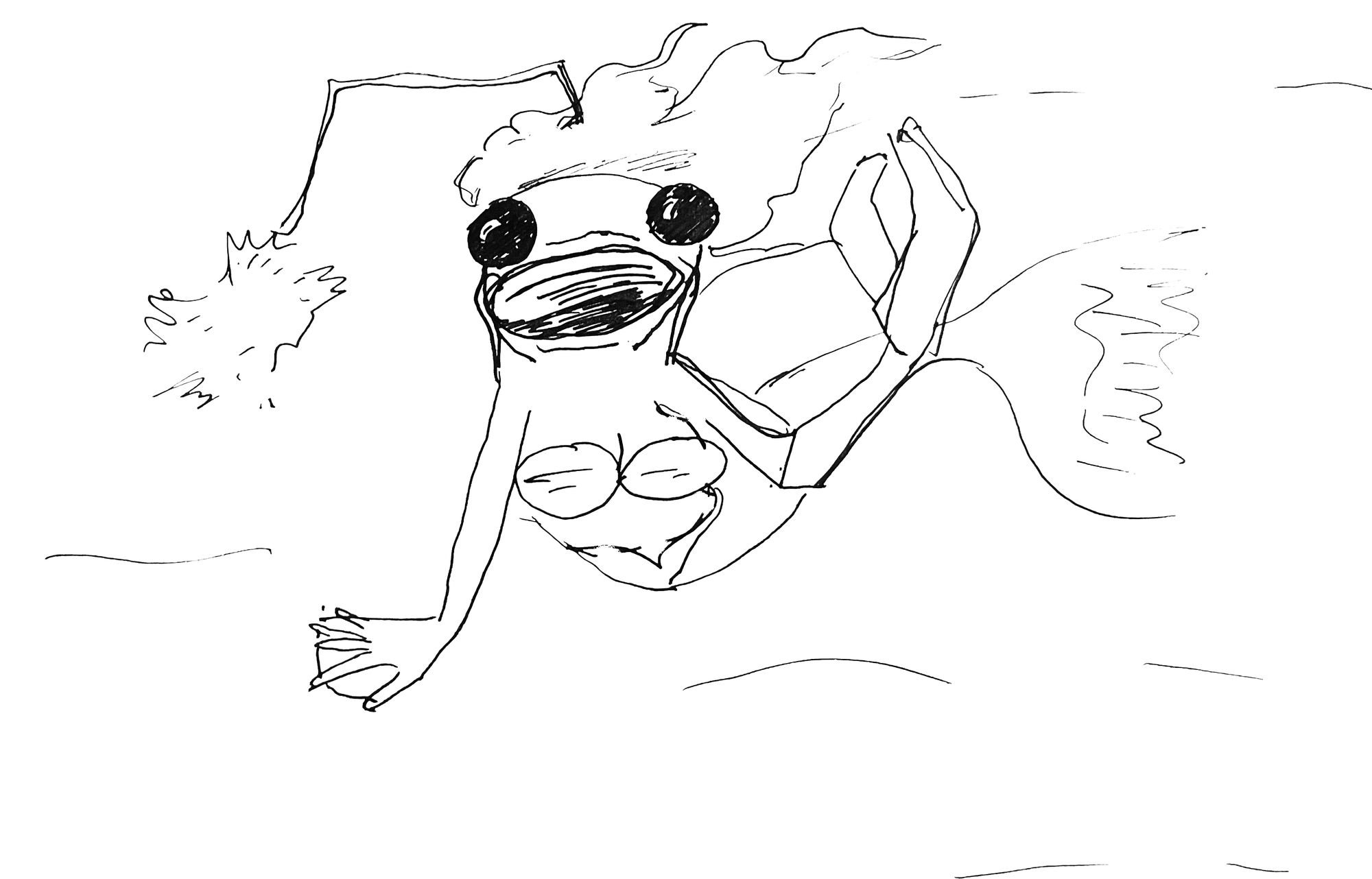The Little Mermaid if it Were Scientifically Accurate

By Celia Mattison
The Little Mermaid, the latest to enter the pantheon of Disney’s live-action remakes, faced a series of seemingly impossible production challenges. Putting aside the technical difficulties of rendering an undersea adventure, how do you depict even semi-realistic fish that audiences might love and not want to deep fry? As an amateur scuba diver and general marine enthusiast, I was thrilled by the idea of a Little Mermaid that might more fully embrace the strange beauty of the ocean floor. What better place to update the superannuated gender and body politics of the ‘89 animated version than the original fluid icon—the sea?
The hot mermaid—exemplified by the ridiculously luminescent Halle Bailey—has been around for a while, but the cute mermaid is much newer. Most classical art depicts mermaids as beautiful and dangerous—a trope replicated by the proto-Ariel mermaids of Disney’s Peter Pan (1953). In the original The Little Mermaid, the merfolk (with the exception of Ursula) seem far more human than fish, their pisciform parts adorable rather than monstrous.
Most portrayals of mermaids uphold western standards of beauty though Bailey has proved that whiteness is no longer a prerequisite. But evolution is not just about hotness, it’s also about survival. And I’d guess mermaids have plenty of predators to contend with, whether they be sharks or orcas or billionaires on submarines. If we gave greater weight to the biological adaptations that would offer the merfolk the best chance of survival, we’d probably end up with a very different Ariel than the one Disney has delivered.
Here are ten possible adaptations that would serve the merfolk well, ranked from most audience-friendly and charming to studio executive’s worst nightmare.
- Blubber. The original glamor-puss was inspired by legendary actor and drag queen Divine and fans hoped the queer, fat origins of the character would be honored in the casting of the remake’s Ursula. By comparison, few people called for a fat Ariel—Disney princesses have been wasp-waisted since Snow White. In this case it’s a scientific issue: What does a mermaid need visible abs for? A mermaid would be better suited with a layer of blubber between the skin and tissue, like a dolphin or seal. Blubber provides insulation, an energy reserve, and buoyancy, and would give our merfolk a gloriously soft shape and a better shot at survival.
- Bioluminescence. Shocking no one: it is dark underwater. If Ariel is making dives through shipwrecks, some type of bioluminescence might be helpful to guide her way. An illuminated tail would certainly suffice, though a dangling lure like that of a female anglerfish would be far more intriguing.
- Mucus membrane. Perhaps mermaids know better to touch the stinging fire corals that dot the reef but Ariel reclines comfortably atop a cloud of jellyfish. It would reason that mermaids might have an adaptation similar to clownfish, who have a mucus coat that protects them from the sea anemones with whom they form a symbiotic relationship.
- Sharkskin. The soft, vulnerable skin of a human would be a major liability underwater. I can only imagine the chafing going on under Triton’s breastplate. If mermaids are not entirely scaly, they might have evolved a skin similar to that of sharks and rays, who have tough, aerodynamic scales that allow them to cruise effortlessly through the water. While we’re on the subject of speed, hair would only cause drag, so for realism these mermaids should be mostly bald.
- Gills. As mermaids are forbidden to surface because of human activity, we assume they can get all their oxygen from the water and thus would have gills. However, mermaids are also able to comfortably exit the sea to sing and talk, so they might have a bonus set of lungs, like the lungfish which can survive on land for a few days. In that case, these lungs and the ribcage surrounding them might also be collapsible like that of a sperm whale, one of the deepest diving marine mammals.
- Webbed hands. Mermaids require opposable thumbs to hold tridents and unhook shell bras, so full fins would be useless. However, slight webbing in between the fingers would be useful for swimming. It might also assist in hand-stuff when it comes to the murky subject of mermaid reproduction.
- Giant squid eyes. Alongside the wasp waist, heavy-lashed doe eyes might be the most essential Disney princess attribute even though human eyes are ill-suited for underwater vision. Many fish don’t even have eyelids—some, like the hagfish, don’t even have eyes, just eyespots. The enormous, glossy eye of the colossal squid, or the independently moveable eye stalks of the mantis shrimp would be useful underwater for spotting predators and prey. Personally, I think the round, inky eyes of a harbor seal would be the most adorable.
- Claw. There is a reason that nature evolves a crab, God’s perfect animal. One large claw, like that of a fiddler crab, would be a useful adaptation both for protection and communication. It might also take Sebastian down a peg.
- Baleen. Triton expresses disgust at the idea of consuming fish, and Sebastian’s main argument against land-dwelling is the danger of being eaten, so we can assume mermaids are not piscivores. So then, how does a large, active animal like a mermaid get enough calories? Just look at the largest animal on earth, the blue whale. Rather than chomping down like their toothed cousins, blue whales and other baleen whales filter thousands of pounds of tiny animals like krill and plankton through massive keratin plates. Mermaids might have something similar. Alternatively, consider a mermaid with the gaping, muppetesque maw of a whale shark.
- Hammerhead. The oblong shape of the hammerhead shark is one of the most recognizable silhouettes in the animal kingdom. There are many scientific theories behind the evolution of the hammerhead, or cephalofoil, including improved vision, increased coverage of the shark’s electroreceptors which allow it to detect other animals’ electric fields, and it looking cool as hell. With eyes on either side of her long head, Ariel would have a 360 degree field of vision that would enable her to spot predators, prey, and better choices for her future.





Comments ()